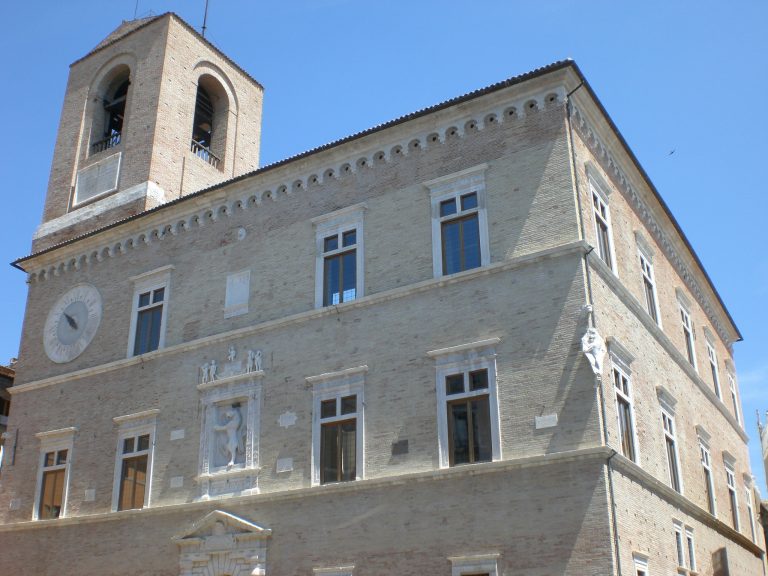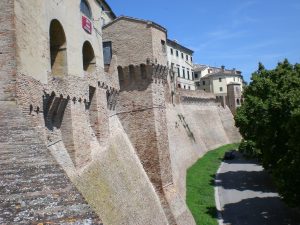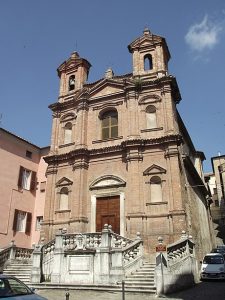
La leggenda ci racconta che Jesi fu fondata dal Re dei Pelasgi nel 768 a.C. anche se verosimilmente furono gli Umbri a fondarla come avamposto verso il mare. I Galli Senoni (chiamati così dalla zona di provenienza dove oggi sorge la città di Sens in Francia) cacciarono gli Umbri e si stabilirono nell’area nel IV secolo a.C. Fu poi la volta dei romani che nel 283 a.C. sconfissero i Galli costringendoli alla sottomissione. Diverse furono le devastazioni da parte di Odoacre e in seguito dagli Ostrogoti dopo la caduta dell’impero romano. Fu poi la volta dei Bizantini che la inclusero nel loro territorio. I Longobardi nel 751 la conquistarono e la devastarono. Ma pochi anni dopo, Pipino il Breve ne venne in possesso e la donò alla Chiesa. Diverse furono le ribellioni dei vari comuni, inclusa Jesi, contro il governo papale e poi contro Ancona. Insomma, la storia di Jesi è un continuo cambiamento. Anche i Borboni per un periodo ne furono in possesso.
La sua posizione strategica indusse prima i romani a costruire e in seguito, quando divenne comune a se stante, a rinforzare la cinta muraria. Tra le meglio conservate nelle Marche, con un perimetro di 1,5 Km.
Tantissimi i palazzi nobiliari. Ricordiamo tra i tanti il Palazzo della Signoria, quello di Colocci, il Balleani e il Ripanti. 2 sono i teatri della città : il Teatro Pergolesi e il Teatro Valeria Moriconi. Mentre la lista delle chiese è lunghissima. Qui ricordiamo solo il Duomo di San Settimio, la chiesa di San Marco, la chiesa di San Nicolò e quella di San Pietro e Paolo con la bellissima scalinata presente nella facciata.
Legend tells us that Jesi was founded by the King of the Pelasgians in 768 BC. even if they were probably the Umbrians as an outpost towards the sea. The Senoni Gauls (so called from the area of origin where today the city of Sens stands in France) hunted the Umbrians and settled in the area in the 4th century BC. It was then the turn of the Romans who in 283 BC they defeated the Gauls by forcing them into submission. Several were the devastations by Odoacer and later by the Ostrogoths after the fall of the Roman Empire. It was the turn of the Byzantines who included it in their territory. The Lombards in 751 conquered and devastated it. But a few years later, Pepin the Short came into possession of it and donated it to the Church. Several were the rebellions of the various municipalities, including Jesi, against the papal government and then against Ancona. In short, the history of Jesi is a continuous change. Even the Bourbons were in possession of it for a period.
Its strategic position led the Romans first and later (when it became a municipality in its own right) to build a wall, one of the best preserved in the Marche, with a perimeter of 1.5 km.
Many noble palaces. We remember among the many the Palazzo della Signoria, that of Colocci, the Balleani and the Ripanti. There are 2 theaters in the city: the Pergolesi Theater and the Valeria Moriconi Theater. While the list of churches is very long. Here we only remember the Cathedral of San Settimio, the church of San Marco, the church of San Nicolò and that of San Pietro e Paolo with the beautiful staircase in the facade.

Legend tells us that Jesi was founded by the King of the Pelasgians in 768 BC. even if they were probably the Umbrians as an outpost towards the sea. The Senoni Gauls (so called from the area of origin where today the city of Sens stands in France) hunted the Umbrians and settled in the area in the 4th century BC. It was then the turn of the Romans who in 283 BC they defeated the Gauls by forcing them into submission. Several were the devastations by Odoacer and later by the Ostrogoths after the fall of the Roman Empire. It was the turn of the Byzantines who included it in their territory. The Lombards in 751 conquered and devastated it. But a few years later, Pepin the Short came into possession of it and donated it to the Church. Several were the rebellions of the various municipalities, including Jesi, against the papal government and then against Ancona. In short, the history of Jesi is a continuous change. Even the Bourbons were in possession of it for a period.
Its strategic position led the Romans first and later (when it became a municipality in its own right) to build a wall, one of the best preserved in the Marche, with a perimeter of 1.5 km.
Many noble palaces. We remember among the many the Palazzo della Signoria, that of Colocci, the Balleani and the Ripanti. There are 2 theaters in the city: the Pergolesi Theater and the Valeria Moriconi Theater. While the list of churches is very long. Here we only remember the Cathedral of San Settimio, the church of San Marco, the church of San Nicolò and that of San Pietro e Paolo with the beautiful staircase in the facade.

Comune di Jesi
Palazzo Comunale
Piazza Indipendenza, 1
60035 Jesi (AN) – Tel 0731 5381
